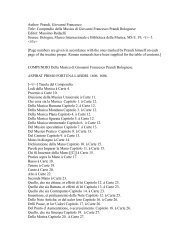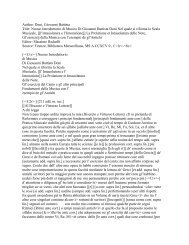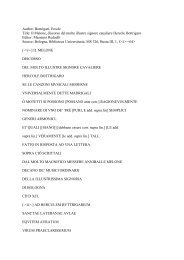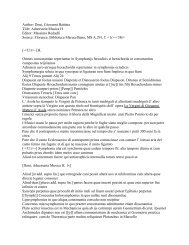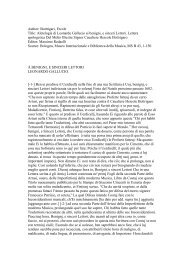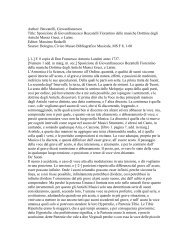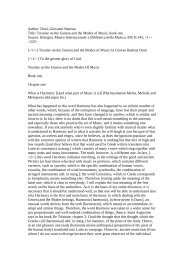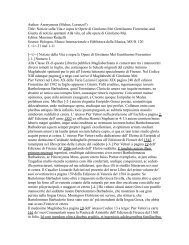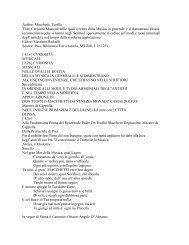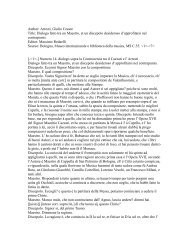Author: Dentice, Luigi - manuscripts of italian music theory in ...
Author: Dentice, Luigi - manuscripts of italian music theory in ...
Author: Dentice, Luigi - manuscripts of italian music theory in ...
Create successful ePaper yourself
Turn your PDF publications into a flip-book with our unique Google optimized e-Paper software.
is one tone removed from the hypate hypaton. S<strong>in</strong>ce the proslambanomenos sounds the<br />
consonance <strong>of</strong> a diapason with the mese it is at the distance <strong>of</strong> an octave with it. Its<br />
distance from the lichanoshypaton is a fourth, and it sounds a diatessaron, while the<br />
lichanoshypaton is at the distance <strong>of</strong> a fifth from the mese and sounds a diapente. The<br />
mese is at the distance <strong>of</strong> a tone from the paramese and <strong>of</strong> a fifth from the nete<br />
diezeugmenon. The netehyperboleon is a fourth and sound the diatessaron, while the<br />
proslambanomenos to the neterhyperboleon sounds the consonance <strong>of</strong> the bisdiapason, or<br />
fifteenth. You must bear <strong>in</strong> m<strong>in</strong>d, so that you may have no difficulty start<strong>in</strong>g now from the<br />
hypate now from the proslambanomenos, that <strong>music</strong>ians take different notes as their<br />
beg<strong>in</strong>n<strong>in</strong>g. In fact, sometimes they start from the lowest hypate and sometimes from the<br />
added note (proslambanomenos). If there is the bisdiapason, where one f<strong>in</strong>ds fifteen note,<br />
the proslambanomenos note is added, but <strong>in</strong> the others, and especially <strong>in</strong> the tones or<br />
tropes, as we want to call them, the first one is the hypate hypaton, which generates all the<br />
species <strong>of</strong> any consonance. Therefore, it is not without reason that the proslambanomenos<br />
sometimes has the lowest places, be<strong>in</strong>g the added note, and sometimes the one above it<br />
correspond<strong>in</strong>g to hypate hypaton, s<strong>in</strong>ce it is necessary that the <strong>music</strong>ian should m<strong>in</strong>d the<br />
truth <strong>of</strong> the matter rather than the position <strong>of</strong> the note, as one can see <strong>in</strong> the follow<strong>in</strong>g<br />
illustration.<br />
[-f.17v-] [<strong>Dentice</strong>, First Dialogue, 17v; text: tetracordo hypaton. Meson. diezeugmenon.<br />
hyperboleon. tono, semitono, diezeusis, A, G, F, E, D, C, b [sqb], 1276. Nete<br />
hyperboleon. 648, Paranete, 229, Trite: 768, Netediezeugmenon, 864, Paranete<br />
diezeugmenon, 972, Trite, 1014, Paramese, 1152, Mese, 1296, Lycanos meson, 1458,<br />
Parhypate, 1536, Hypate, 1728, Licanos, 1944, 2048, Hypate hypaton, 2304,<br />
Proslambanomenos.]<br />
[-f.18r-] Serone. Personally, had I not seen the illustration, I would never have understood<br />
this difference, because it is a highly complex matter.<br />
Soardo. It is possible, but let us return to our purpose. Every <strong>music</strong> writer states that the<br />
genera <strong>of</strong> <strong>music</strong> are three, namely, the diatonic, the enharmonic and the chromatic. The<br />
diatonic is the one that has five tetrachords <strong>in</strong> total, which are hypaton meson,<br />
s<strong>in</strong>emmeon, diezeugmenon and hyperboleon. It rises through m<strong>in</strong>or semitone, tone and<br />
tone, and it descends through tone, tone and m<strong>in</strong>or semitone. It is called diatonic because<br />
it moves from a tone to another one. This tetrachord is the most settled, stable and natural<br />
to the ear. The enharmonic one rises <strong>in</strong> every tetrachord through diesis, diesis and ditone.<br />
It is called enharmonic because it is superior to every other genus, while the chromatic<br />
differs from the diatonic because its tetrachord rises through semitone, semitone and three<br />
semitones, rather than through tone, tone and m<strong>in</strong>or semitone, and descends through three<br />
semitones, semitone and semitone. This tetrachord is very s<strong>of</strong>t and full <strong>of</strong> emotions, and it<br />
derives its name from the surfaces that pass from one colour to another one when they<br />
change. Note that all the tetrachords <strong>of</strong> the diatonic genus are divided <strong>in</strong>to two tones and a<br />
m<strong>in</strong>or semitone. This genus is called uncompounded tone, because it is laid out as a<br />
whole and noth<strong>in</strong>g is added to it, but every <strong>in</strong>terval is whole. The division <strong>of</strong> the<br />
chromatic is <strong>in</strong>to semitone, semitone and three semitones and it is called uncompounded<br />
trihemitonium, because it is placed with<strong>in</strong> one <strong>in</strong>terval. The trihemitonium occurs also <strong>in</strong><br />
the diatonic, but it cannot be called uncompounded, because it consists <strong>of</strong> two <strong>in</strong>tervals.<br />
The enharmonic consists <strong>of</strong> diesis, diesis and ditone, which, for the same reason, as it is<br />
placed with<strong>in</strong> a s<strong>in</strong>gle <strong>in</strong>terval, is called uncompounded. All <strong>of</strong> these three genera are<br />
conta<strong>in</strong>ed with<strong>in</strong> the tetrachord, or [-f.18v-] the consonance <strong>of</strong> the diatessaron. In fact, the<br />
diatonic, which proceeds through m<strong>in</strong>or semitone, tone and tone, completes the



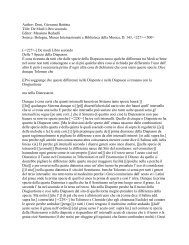
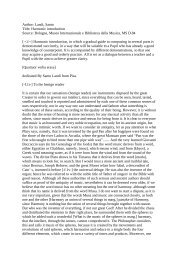
![Doni, Giovanni Battista Title: Trattato Dei Tuoni o [[Harmonie de]]](https://img.yumpu.com/45461005/1/190x245/doni-giovanni-battista-title-trattato-dei-tuoni-o-harmonie-de.jpg?quality=85)
